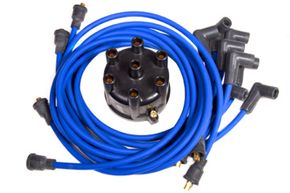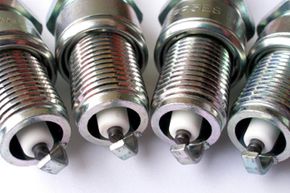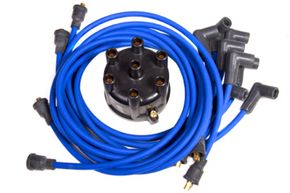\”

Way back in the bad old days, which when you\’re talking about car ignition systems is anytime before 1980, car part longevity was actually pretty awful. All cars used distributors, rotors and contact points, in addition to spark plugs and wires. All those extra moving parts could (and would) wear out pretty quickly. In the case of contact points, it was recommended that they be replaced as often as once a year. The distributor cap, rotor and spark plugs could make it longer, and were often replaced at the 30,000-mile (48,280-kilometer) tune-up. Spark plug wires held out the longest, with a recommended change at around 90,000 miles (144,841 kilometers).
By the 1990s, distributorless ignition systems were becoming more common. Many cars were getting on-board computers with sensors that could control the ignition system instead of the older, moving car parts. These more modern cars controlled spark with crankshaft and camshaft position sensors. The sensors sent a signal to the computer, and the computer triggered the coil.
Doing away with auto parts like the distributor meant better control of the ignition and spark timing. Even though there\’s often only one coil for every two spark plugs, the coils are long-lived. Most car part information guides don\’t list a recommended replacement interval for the coil, and they could potentially last as long as the car. And since the coils are so close the spark plugs in a distributorless system, the spark plug wires are shorter and less likely to require replacement, too. The platinum-tipped spark plugs often used in these systems have a 60,000-mile (96,561-kilometer) lifespan.
But now, in the 21st century, ignition systems use iridium-tipped spark plugs that regularly last as long as 100,000 miles (160,934 kilometers). Auto part longevity in the new coil-on-plug (COP) systems means that some new car owners might never have to deal with ignition maintenance. In a COP system, the spark plug wires are eliminated, and each spark plug well has its own coil. The coil snaps right onto the plug, meaning there are no longer any moving parts to wear out or wires to replace.
But there\’s more auto part information to be had; after all, even these new-fangled COP systems can\’t be without problems, right? Read on to find out what might affect ignition system longevity.
Contents
Factors Affecting Car Ignition Longevity
Car parts in ignition systems before 1980 had several moving parts, and the more these parts had to move, the more quickly they would wear out. The spark plugs, rotor, contact points and coil were often sold together, and the whole shebang would be replaced once a year, or around 15,000 miles (24,140 kilometers). Ignitions that were heavily used, like those in delivery vans or taxis, often needed to replace these worn-out auto parts even more often.
The need for multiple spark plug wires to connect each of the plugs to the one coil that served the whole system could often affect auto part longevity. While spark plug wires could last as long as 60,000 miles (96,561 kilometers), according to Jim Houser of Hawthorne Automotive Clinic, the position of the wires in the engine made a significant difference. If they were close to the hot exhaust manifold, for example, they\’d need to be changed out a lot sooner.
For decades, all the car part information a person could find would recommend the replacement intervals for ignition system components, usually at the 30-, 60-, or 90,000-mile (48,280-, 96,561-, or 144,841-kilometer) tune-ups. But with the new coil-on-plug systems, car part longevity has nearly reached automotive infinity. There are no moving parts to wear out, but if the spark plugs spend 120,000 miles (193,121 kilometers) inside the engine, they might be extremely difficult to remove at that point.
There are a few problems that can affect a COP system, says Leslie Macaulay, an instructor in Automotive Service Technology at Portland Community College, like a fuel mixture that\’s either too rich or too lean. Too rich means too much gas or oil is burning, and it can foul even iridium-tipped plugs. Too lean means there isn\’t enough fuel, and again, the spark plugs suffer. But with normal operation, Macaulay says, modern spark plugs go a long time.
Auto part information and advances in technology have made maintenance of today\’s autos easier than ever. Keep reading to find out what kind of ignition system maintenance still needs to be performed.
Want to know something interesting?
Jim Houser of Hawthorne Automotive Clinic, and Leslie Macaulay an instructor in Automotive Service Technology at Portland Community College, both agree that the number-one factor that affects the longevity of a car\’s ignition cylinder — the place inside your car where you insert your car key — is the number of keys on your key ring. Houser even goes so far as to recommend only one extra key and a fob on the key ring. The weight of the swinging keys can wear out the tumblers inside the ignition cylinder. Macaulay adds that without a pound of keys hanging from it, an ignition cylinder can often last as long as 200,000 miles (321,869 kilometers).
Car Ignition Maintenance


As auto part longevity has increased, the required maintenance has decreased. In fact, without moving auto parts in the ignition system, maintenance is down to nearly nothing. Even car parts like the spark plugs can make it to six figures on the odometer before being changed.
Comparing maintenance intervals for cars built in the last 10 years or so to older cars and trucks with distributors and rotors is "like comparing a washing machine to a washboard," says Macaulay. Spark plug wires, if there are any, are only changed as needed. "Manufacturers don\’t even list a maintenance interval," she says.
But what about all the new computerized auto parts? Don\’t they give out or go on the fritz? Sure, the crankshaft sensor, camshaft sensor and throttle position sensor, among others, can wear out over time, but there\’s no recommended interval for replacement. The powertrain control module (PCM) receives signals from these sensors all the time. If the signal stops, the check engine light comes on, and the code from the PCM will give the repair technician the necessary auto part information to find the exact sensor that needs to be replaced at that time.
This leaves almost nothing for the shade-tree mechanic to do on a Saturday afternoon. Those folks will have to be happy wrenching on cars built before 1980, with their shorter car part longevity and regular maintenance intervals. But all cars need regular oil and filter changes — without that basic bit of maintenance, the ignition system can\’t continue on for 100,000-plus miles (more than 160,934 kilometers) with few repairs.
Even with this reduced maintenance, some ignition system parts will still need to be replaced. Go to the next page for more car part information.
Replacing Car Ignitions


In distributorless and COP systems, few, if any, ignition system parts need to be replaced. But when these auto parts do need to be replaced, it can be tricky.
In some cases, car part longevity can work against itself. Houser points out that if the spark plugs are left in for a full 120,000 miles (193,121 kilometers) or so, they can be very difficult to remove. Steel spark plugs can fuse with aluminum cylinder heads as they bond themselves together. When the repair tech tries to remove the plugs, they can break into several pieces. At the very least, this process requires special tools. In the worst case, the cylinder head will need to be replaced.
And while the PCM and its sensors can perform without fail for years, another new technological addition can cause problems. Electronic theft deterrents are being built into the ignition cylinder to keep thieves from stealing cars. A chip inside the cylinder "talks" to a chip in the key. If it can\’t find that chip, the car won\’t start. So, what happens if the chip in the key fails? Either the car has to be towed to the dealership or a certified specialist needs to come to the car. In either case, the theft deterrent system needs to be reprogrammed. "You don\’t want to screw it up," says Houser, "because it can damage the car\’s computer."
Believe it or not, auto part longevity is about to get even longer. The state of California wants to see an extended warranty on new car ignition systems of 10 years or 150,000 miles (241,402 kilometers). This will mean notching up the quality of the current auto parts, like the crankshaft sensors and the coils. However, Houser thinks the auto manufacturers will have no trouble meeting these new standards.
The reduced need for maintenance and car part replacement means keeping a vehicle for several years is much cheaper than it once was, and with fewer parts being tossed in the garbage, it\’s better for the environment, too. As Macaulay says, "It\’s worlds apart from the cars of the \’70s."
For more information about ignition systems, auto part longevity and other related topics, follow the links on the next page.
Lots More Information
Related HowStuffWorks Articles:
- Top 10 Everyday Car Technologies that Came from Racing
- How Car Computers Work
- How Driverless Cars Will Work
- How Hypercars Work
- How Auto Transport Works
- How Automotive Production Lines Work
- Can you assemble your own car?
- What makes a digital car digital?
- What\’s new in synthetic oil technology?
- Will car repairs in the future financially cripple you?
Sources:
- 2CarPros.com. "How Car Ignition Systems Work." (Oct. 1, 2009)http://www.2carpros.com/how_does_it_work/ignition.htm
- Draper, Dave. "Electronic Ignition Overview." June 2005. (Oct. 1, 2009)http://www.jetav8r.com/Vision/Ignition/CDI.html
- Houser, Jim. Hawthorne Auto Clinic. Personal interview. Conducted on Oct. 8, 2009.
- Macaulay, Leslie. Portland Community College Automotive Service Technology. Personal interview. Conducted on Oct. 7, 2009.
- Weissler, Paul. "Replacing Spark Plugs." March 1998. (Oct. 6, 2009)http://www.popularmechanics.com/how_to_central/automotive/1272191.html












